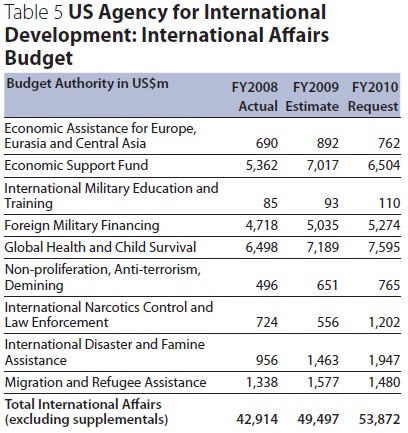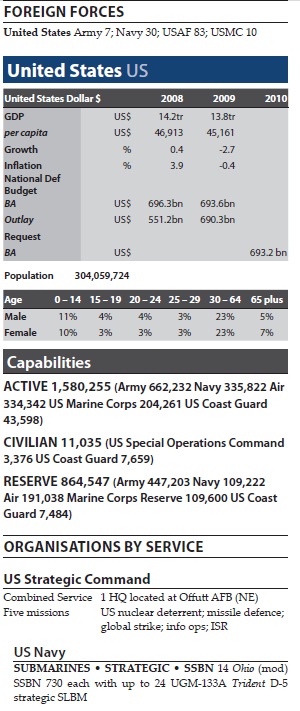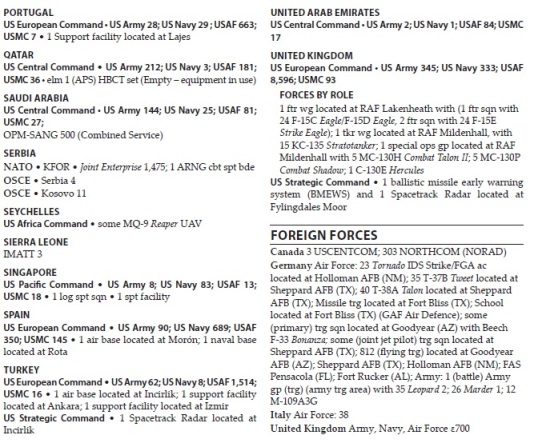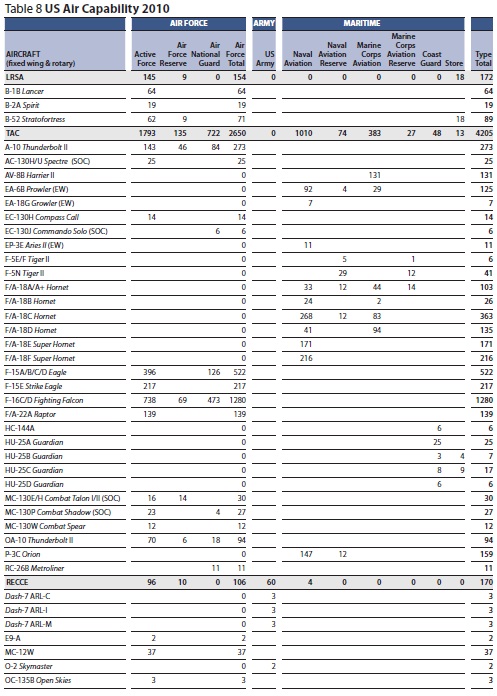FY2010 National Defence Process
In May 2009, three months later than usual, the contents of Obama’s first budget request to Congress were made public. True to his pledge during the election campaign, the FY2010 national-defence request included both a baseline budget proposal of US$587bn together with a further US$130bn to cover overseas contingency operations (OCOs). Under the Bush administration, OCOs had been funded by a separate supplemental appropriation, provoking
criticism that total Pentagon funding was becoming less transparent. Once war costs are stripped out, the FY2010 request represents an increase in the base budget in real terms of around 2% over the previous year, which, as Gates made clear, will be the trend in coming years. In line with Gates’s April statement, the request did not include funds for procurement of either F-22 or C-17 aircraft or the manned groundvehicle portion of the FCS, but did include US$5.5bn
for the procurement of 1,080 MRAP vehicles and US$2.2bn for an Aegis-class ship. Cancellation of the multiple-kill vehicle, airborne-laser and kineticenergy interceptor resulted in a cut in the missiledefence budget request of US$1.4bn. The shift in policy outlined by Gates and presented in Obama’s budget request was broadly endorsed
by both the House and Senate in their respective FY2010 National Defense Authorization bills, in which they acquiesced to most of the programme cuts outlined earlier in the year. Originally, both committees had rejected the call to cease production of the F-22 fighter and to discontinue development of an alternative engine for the F-35 Joint
Strike Fighter, despite a warning from the administration that a bill containing either proposal would be vetoed by the president. However, on 23 July the Senate passed its version of the bill after adopting several amendments, including one that would, in effect, end production of the F-22 as the administration had requested. On 7 October a House–Senate conference committee finalised the FY2010 Defense Authorisation Bill which was duly sent to the president,
who signed it into law on 28 October.
In signing the FY2010 Defense Authorization Act, Obama claimed partial victory in his battle against wasteful Pentagon spending, declaring that the bill eliminated ‘tens of billions of dollars in waste’ by cancelling the procurement of several unnecessary weapons systems. He also warned that the bill, although important in tackling waste, was only ‘a first step’ and that further cuts would be required if the US was to ‘build the 21st-centruy military we need’. The
final authorisation act was very close to the original budget request submitted by Obama, with the exception
that it included funds for C-17 transport aircraft and money for the alternative engine for the Joint Strike Fighter, both programmes that Obama and Gates had wanted to terminate.
Just how much weapons-programme reform is achieved in 2009, however, remains to be seen. Under the rather complex US legislative process, the Defense Authorization Act only shapes defence policies and programmes; actual funding limits are detailed in a separate Defense Appropriations Bill. As of November 2009, the House and Senate
had both passed their own versions of the FY2010 Defense Appropriations Bill; however, there were major differences that needed to be resolved in the conference process, including:
• C-17 transport aircraft. The House wanted to spend US$674m to buy three; the Senate wanted to spend US$2.6bn to buy ten.
• The alternate Joint Strike Fighter engine. The House voted to spend US$560m on it whereas the Senate voted to spend nothing.
• Presidential helicopter. The House voted to spend US$485m to make five helicopters operational. The Senate called for starting a new programme altogether.
• DDG-51 destroyer. The Senate added US$1.7bn for an additional ship. The House wanted to buy just one.
• The House wanted US$80m to preserve the programme.

The Senate, like the White House, wanted to cancel it. Notwithstanding these unresolved matters, the bulk of the Appropriations Act is likely to mirror very closely the already passed Authorization Act. So far as the FY2011 budget request is concerned, there is little reason to expect that it will reverse the new direction signposted by the president and his secretary of defense. The 2010 QDR, of course, will flesh out the Pentagon’s broader programme for the
next four years and is likely to contain further cuts to existing programmes and emphasise the allocation of additional funds to Gates’s priority areas: helicopters, civil affairs, persistent ISR and intratheatre lift. One vulnerable programme is the Marine Corps’ Expeditionary Fighting Vehicle (EFV), which has been plagued by technical problems and has
increased in cost from US$9bn in 2000 to US$13.7bn in 2009. In addition to cost overruns and delays, the
vehicle’s utility has come under question following the Marines’ experience in Afghanistan – the EFV has a flat bottom, making it vulnerable to improvised explosive devices.
The cost of operations since 11 September 2001
With the enactment of the FY2009 Supplemental in June 2009, Congress has approved a total of about US$944bn for military operations, base security, reconstruction, foreign aid, embassy costs and veterans’ health care for the three operations initiated since the 11 September 2001 attacks: Operation Enduring Freedom (Afghanistan and other counter-terrorist operations), Operation Noble Eagle (enhanced security at military bases), and Operation Iraqi Freedom. For the first time since military operations began in 2001, funding for OCOs (previously the ‘global war on
terror’) was included in the president’s budget request. During his election campaign Obama had promised to end the practice of submitting separate supplemental requests to cover OCOs. In recent years there has been heated debate over the use of supplemental appropriations to fund OCOs, with criticism that such funds were increasingly being used to finance regular non-war activities. Historically, DoD financial regulations had defined the cost of OCO-type activities to include only incremental spending directly related to operations. But in October 2006 Deputy Secretary of Defense Gordon England appeared to have given the go-ahead for a broader interpretation of war costs when he issued new guidance to service chiefs that they could include requirements appropriate to the ‘longer war on terror’ in their supplemental requests, rather than limiting requests specifically to the annual costs incurred by operations in Iraq and Afghanistan. The effect of this change is illustrated by the subsequent jump in supplemental procurement requests,
which rose from US$18bn in FY2005 to US$64bn in FY2008, and although some of this increase may reflect the cost of additional force protection and replacement of ‘stressed’ equipment, much may be in response to the new guidance. For example, requests for ‘resetting’ military equipment used in overseas operations became increasingly difficult to interpret. Resetting is usually limited to the replacement of war-worn equipment; however, the Pentagon’s definition of reset has expanded significantly and now includes not only replacing battle losses (typically 10% of the total) and equipment repair (about half), but also recapitalisation that typically upgrades current equipment, and the repair and replacement of pre-positioned equipment stored overseas that has been tapped to meet war needs. Given that the
army, in particular, had been planning to recapitalise equipment and modernise pre-positioned equipment stocks to match its new modular configuration, it is questionable whether these costs were indeed wartime requirements.
In addition to US$130bn for DoD activities, the FY2010 war request includes US$6.4bn for the State Department’s foreign and diplomatic operations and US$2.1bn for Veterans Administration medical costs for Operation Enduring Freedom and Operation Iraqi Freedom veterans. On the face of it this would suggest that overall war funding is decreasing from a peak of US$185bn in FY2008, a consequence of the surge strategy in Iraq that year, to US$150bn in FY2009 and US$130bn in FY2010. However, given that the president has authorised a further 30,000 troops for
Afghanistan, it seems certain that he will have to return to Congress with an additional supplemental request. In a January 2009 update, the Congressional Budget Office projected that additional war costs for FY2010 to FY2019 could range from US$388bn (if deployed troops fall to 30,000 by 2011) to US$867bn (if troop levels only fall to 75,000 by 2013), meaning that funding for Iraq, Afghanistan, and other OCOs could total US$1.3–1.8tr for 2001–19, depending on the scenario.

 US Air Force • Air Combat Command
US Air Force • Air Combat Command
Bbr 6 sqn (incl 1 AFRC) at 2 AFB with 71 B-52H Stratofortress each with up to 20 AGM-86B nuclear ALCM and/or AGM-129A nuclear ACM; 2 sqn at 1 AFB with 19 B-2A Spirit each with up to 16 free-fall bombs (or up to 80 when fitted with Small Diameter Bombs); 4 B-52 test hvy bbr; 1 B-2 test hvy bbr
Air Force Space Command
Msl 9 sqn at 3 AFB with 500 LGM-30G Minuteman III (capacity 1-3 MIRV Mk12/Mk12A per missile) Strategic Recce/Intelligence Collection (Satellites)
SPACE BASED SYSTEMS
SATELLITES 63
IMAGERY 6: 4 Improved Crystal (visible and infrared imagery, resolution 6 inches); 2 Lacrosse (Onyx radar imaging satellite)
ELINT/SIGINT 19: 3 Mentor (advanced Orion; 1 Advanced Mentor; 5 Trumpet; 2 Mercury; 8 SBWASS (Space Based Wide Area Surveillance System); Naval Ocean Surveillance System
ELECTRONIC OCEAN RECCE SATELLITE 6: 1
GFO (Global Follow-On); 5 DMSP-5
SATELLITE TIMING AND RANGING 32: 12
NAVSTAR Block I/II/IIA; 20 NAVSTAR Block IIR (components of Global Positioning System (GPS))
SENSORS • NUCLEAR DETONATION DETECTION
24: (detects and evaluates nuclear detonations.
Sensors deployed in NAVSTAR satellites) Strategic Defenses – Early Warning North American Aerospace Defense Command (NORAD), a combined US–CAN org.
SPACE BASED SYSTEMS • SATELLITES 4 Defense Support Programme DSP (Infra-red surveillance and warning system. Detects missile launches, nuclear detonations, ac in afterburn, spacecraft and terrestrial infra-red events. Approved constellation: 4 operational satellites; 1 operational on-orbit spare)
NORTH WARNING SYSTEM 15 North Warning System Long Range (range 200nm); 40 North Warning System Short Range (range 110–150km)
OVER-THE-HORIZON-BACKSCATTER RADAR (OTH-B) 2: 1 AN/FPS-118 OTH-B (500–3,000nm) located at Mountain Home AFB (ID); 1 non-operational located at Maine (ME)
STRATEGIC 2 Ballistic Missile Early Warning System BMEWS located at Thule, GL and Fylingdales Moor, UK; 1 (primary mission to track ICBM and SLBM; also used to track satellites) located at Clear (AK) SPACETRACK SYSTEM 11: 8 Spacetrack Radar located at Incirlik (TUR), Eglin (FL), Cavalier AFS (ND), Clear (AK), Thule (GL), Fylingdales Moor (UK), Beale AFB (CA), Cape Cod (MA); 3 Spacetrack Optical Trackers located at Socorro (NM), Maui (HI), Diego
Garcia (BIOT)
USN SPACE SURVEILLANCE SYSTEM NAV
SPASUR 3 strategic transmitting stations; 6 strategic receiving sites in southeast US PERIMETER ACQUISITION RADAR ATTACK CHARACTERISATION SYSTEM PARCS 1 at Cavalier AFS, (ND) PAVE PAWS 3 at Beale AFB (CA), Cape Cod AFS (MA), Clear AFS (AK); 1 (phased array radar 5,500km range) located at Otis AFB (MA)
DETECTION AND TRACKING RADARS Kwajalein Atoll, Ascension Island, Antigua, Kaena Point (HI), MIT Lincoln Laboratory (MA) GROUND BASED ELECTRO OPTICAL DEEP SPACE SURVEILLANCE SYSTEM GEODSS Socorro
(NM), Maui (HI), Diego Garcia (BIOT) STRATEGIC DEFENCES – MISSILE DEFENCES SEA-BASED: Aegis engagement cruisers and destroyers in Pacific Fleet LAND-BASED: 21 ground-based interceptors at Fort Greeley, (AK); 3 ground-based interceptors at Vandenburg, (CA).
US Army 553,044; 77,833 active ARNG; 31,355 active AR (total 662,232)
FORCES BY ROLE
The US Army continues its transition programme. The aim at present is to have an Active Component of 17 Heavy Brigade Combat Teams (HBCT), 20 Infantry BCT (IBCT) and 8 Stryker BCT (SBCT). The Reserve is planned to comprise
7 HBCT, 20 IBCT and 1 SBCT. The SBCT has 3 manoeuvre bn instead of 2, as in the HBCT and IBCT. The HBCT has 2
combined arms bn, an armed recce sqn, an armd fires bn, a Bde Support Bn (BSB) and a Bde Special Troops Bn (BSTB).
The IBCT has 2 inf bn, a Reconnaissance, Surveillance and Target Acquisition (RSTA) squadron, a fires bn, a BSB and
a BSTB. The SBCT has three Stryker infantry bn, an RSTA sqn, a fires bn, a BSB, and engr, sigs, MI and anti-armour
coys. The army currently projects 18 division headquarters in the total force (10 Active and 8 ARNG). The army still
plans to grow to include 73 BCTs (45 AC BCTs and 28 RC BCTs) and approximately 225 support brigades.
Comd 6 army HQ; 3 corps HQ 10 div HQ Armd 15 HBCT (each: 2 (combined arms) armd / armd inf bn, 1 armd recce sqn, 1 SP arty bn, 1 BSTB, 1 BSB)
Armd Cav 1 heavy regt (3rd ACR) with 3 cav sqn (each: 3 cav tps, 1 tk coy, 1 arty bty), 1 air cav sqn with (3 atk tps, 1 lift coy), 1 chemical coy, 1 engr coy, 1 MI coy; 1 regt (11th ACR) – OPFOR Armd Inf 2 bde (170th, 172nd) with (1 armd bn, 2 armd inf bn, 1 armd recce tp, 1 SP arty bty, 1 cbt engr bn, 1 BSB)
Mech Inf 6 SBCT (each: 1 HQ coy, 3 Stryker bn, 1 fd arty bn, 1 recce sqn, 1 AT coy, 1 engr coy, 1 sigs coy , 1 MI coy ,1 BSB) Inf 10 IBCT (each: 2 inf bn, 1 recce sqn, 1 fd arty bn, 1 BSB, 1 BSTB) Air Aslt 4 BCT (each: 2 air aslt bn, 1 RSTA bn, 1 arty bn, 1 BSB, 1 BSTB (1 MI coy, 1 engr coy, 1 sigs coy)) AB 6 BCT (each: 2 para bn, 1 recce bn, 1 arty bn, 1
BSB, 1 BSTB (1 MI coy, 1 engr coy, 1 sigs coy)) Arty 6 (Fires) bde (each: HQ coy, 1 MLRS bn, 1 UAV coy , 1 TA coy, 1 BSB bn) Engr 5 bde AD 5 bde with MIM-104 Patriot Cbt Avn 11 CAB (5 heavy, 4 medium, 2 light) (each: 1 aslt hel bn, 2 atk hel bn, 1 avn spt bn, 1 gen spt avn bn); 1 (theatre avn) bde Spt 13 (Sustainment) bde (each: 1 BSTB, 2 Cbt Spt bn, 1 Sigs coy) Cbt Spt 2 (3rd bde late 2010) (Manoeuvre enhancement) bde (each: 1 spt bn, 1 sigs coy) Surv 3 BfSB (each: 1 reconnaissance and surveillance sqn, 1 BSTB bn, 1 MI bn) forming WMD / NBC / EOD 1 (CBRNE) comd (1 Chemical bde (2 chemical bn), 1 asymmetric warfare regt (initially under direct FORSCOM C2), 2 EOD gp (each: 2 EOD bn)) SF See US Special Operations Command)
US Navy 329,390; 6,432 active reservists (total 335,822)
Comprises 2 Fleet Areas, Atlantic and Pacific. All combatants divided into 6 Fleets: 2nd – Atlantic, 3rd – Pacific, 4th
– Caribbean, Central and South America, 5th – Indian Ocean, Persian Gulf, Red Sea, 6th – Mediterranean, 7th –
W. Pacific; plus Military Sealift Command (MSC); Naval Reserve Force (NRF); for Naval Special Warfare Command,
see US Special Operations Command element.
EQUIPMENT BY TYPE
SUBMARINES 71 STRATEGIC • SSBN 14 Ohio (mod) SSBN 730 opcon US STRATCOM each with up to 24 UGM-133A Trident D-5 strategic SLBM TACTICAL 57 SSGN 4 Ohio (mod), with total of 154 Tomahawk LAM SSN 53: 22 Los Angeles each with 4 single 533mm TT each with Mk48 Sea Arrow HWT/UGM-84 Harpoon USGW 23 Los Angeles imp, each with up to 12 Tomahawk LAM, 4 single 533mm TT each with Mk48 Sea Arrow HWT/UGM-84 Harpoon USGW 3 Seawolf, each with 8 single 660mm TT each with up to 45 Tomahawk LAM/UGM-84C Harpoon USGW, Mk48 Sea Arrow HWT
5 Virginia with SLCM Tomahawk, 4 single 533mm TT each with Mk48 ADCAP mod 6 HWT, 1 12 cell vertical launch system (12 eff.) (6th vessel expected ISD 2010; additional vessels in build) PRINCIPAL SURFACE COMBATANTS 110
AIRCRAFT CARRIERS 11
CVN 11:
1 Enterprise (typical capacity 55 F/A-18 Hornet FGA ac; 4 EA-6B Prowler ELINT EW ac; 4 E-2C Hawkeye AEW
ac; 6 S-3B Viking ASW ac; 4 SH-60F Seahawk ASW hel; 2 HH-60H Seahawk SAR hel) with 3 Mk 29 Sea Sparrow
octuple each with RIM-7M/RIM-7P, 2 Mk 49 RAM (may be fitted) with 21 RIM-116 RAM SAM 10 Nimitz (typical capacity 55 F/A-18 Hornet FGA ac; 4 EA-6B Prowler ELINT EW ac; 4 E-2C Hawkeye AEW ac; 4 SH-60F Seahawk ASW hel; 2 HH-60H Seahawk SAR hel) each with 2–3 Mk 29 Sea Sparrow octuple each with RIM-7M/RIM-7P, 2 Mk 49 RAM with 42 RIM-116 RAM SAM CRUISERS • CG • 22 Ticonderoga Aegis Baseline 2/3/4 (CG-52-CG-74) each with, comd and control, 2 quad (8 eff.) each with RGM-84 Harpoon SSM, 2 61 cell Mk 41 VLS (122 eff.) each with SM-2 ER SAM/Tomahawk LAM, 2 127mm gun 2 SH-60B Seahawk ASW hel, (Extensive upgrade programme scheduled from 2006–2020, to include sensors and fire control systems, major weapons upgrade to include Evolved Sea Sparrow (ESSM), SM-3 / SM-2 capability and 2 MK 45 Mod 2 127mm gun)
DESTROYERS • DDG 56: 28 Arleigh Burke Flight I/II each with Aegis comd and control, 1 32 cell Mk 41 VLS (32 eff.) with ASROC tactical/ASSM SSM/SM-2 ER SAM/Tomahawk TLAM, 1 64 cell Mk 41 VLS (64 eff.) with ASROC/ASSM SSM/
SM-2 ER SAM/Tomahawk TLAM, 2 quad (8 eff.) each with RGM-84 Harpoon SSM, 2 Mk 49 RAM with 42 RIM-116 RAM SAM, 2 triple ASTT (6 eff.) each with Mk 46 LWT, 1 127mm gun, 1 hel landing platform 28 Arleigh Burke Flight IIA each with Aegis comd and control, 1 32 cell Mk 41 VLS (32 eff.) with ASROC tactical/ASSM SSM/SM-2 ER SAM/Tomahawk TLAM, 1 64 cell Mk 41 VLS (64 eff.) with ASROC/ASSM SSM tactical/SM-2 ER SAM/Tomahawk TLAM, 2 quad (8
eff.) each with RGM-84 Harpoon SSM, 2 triple ASTT (6 eff.) each with Mk 46 LWT, 1 127mm gun, 2 SH-60B Seahawk ASW hel, (Ongoing build programme for 10 additional ships) FRIGATES 21 FFG 21 Oliver Hazard Perry each with 2 triple 324mm ASTT (6 eff.) with 24 Mk 46 LWT, 1 76mm gun, (capacity 2 SH-60B Seahawk ASW hel) LCS 2: 1 Freedom with RIM-116 RAM, MK-15 Phalanx CIWS, 1 57mm gun, (standard capacity either 2 MH-60R/S Seahawk hel or 1 MH-60 with 3 Firescout UAV) (1st of class undergoing trials) 1 Independence with RIM-116 RAM, MK-15 Phalanx
CIWS, 1 57mm gun (standard capacity 1MH-60R/S Seahawk hel and 3 Firescout UAV) (1st of class undergoing trials)
PATROL AND COASTAL COMBATANTS 16 PFC 8 Cyclone PCI 8 MINE WARFARE • MINE COUNTERMEASURES 9
MCM 9 Avenger (MCM-1) each with 1 SLQ-48 MCM system, 1 SQQ-32(V)3 Sonar (mine hunting) ML (none dedicated)
COMMAND SHIPS • LCC 2: 2 Blue Ridge (capacity 3 LCPL; 2 LCVP; 700 troops; 1 med utl hel)
AMPHIBIOUS
PRINCIPAL AMPHIBIOUS SHIPS 31 LHD 8: 8 Wasp (capacity 5 AV-8B Harrier II FGA; 42 CH-46E Sea Knight spt hel; 6 SH-60B Seahawk ASW hel; 3 LCAC(L) ACV; 60 tanks; 1,890 troops) each with 2 Mk 29 Sea Sparrow octuple with 32 RIM-7M/RIM-7P, 2 Mk 49 RAM with 42 RIM-116 RAM SAM, (Additional platform in build) LHA 2: 2 Tarawa (capacity 6 AV-8B Harrier II FGA ac; 12 CH-46E Sea Knight spt hel; 9 CH-53 Sea Stallion spt hel; 4 LCU; 100 tanks; 1,900 troops) each with 2 Mk 49 RAM with 42 RIM-116 RAM SAM LPD 9: 4 Austin (capacity 6 CH-46E Sea Knight spt hel; 2
LCAC(L) ACV/LCU; 40 tanks; 788 troops) 5 San Antonio (capacity 1 CH-53E Sea Stallion hel or 2 CH-46 Sea Knight or 1 MV-22 Osprey; 2 LCAC(L); 14 AAAV; 720 troops) (additional 4 hulls in build; current programme totals 9 units)
LSD 12: 4 Harpers Ferry (capacity 2 LCAC(L) ACV; 40 tanks; 500 troops) each with 1–2 Mk 49 RAM with 21–42
RIM-116 RAM SAM, 1 hel landing platform (for 2 CH-35) 8 Whidbey Island (capacity 4 LCAC(L) ACV; 40 tanks;
500 troops) each with 2 Mk 49 RAM with 42 RIM-116 RAM SAM, 1 hel landing platform (for 2 CH-53) AMPHIBIOUS CRAFT 269+ LCU 34 LCU-1600 (capacity either 2 M1-A1 Abrams MBT or 350 troops) LCVP 8 LCPL 75 LCM 72
ACV 80 LCAC(L) (capacity either 1 MBT or 60 troops; (undergoing upgrade programme)) SF EQUIPMENT 6 DDS opcon USSOCOM
US Special Operations Command 31,496; 3,376 (civilian); 11,247 reservists (SOF) (total 46,119)
Commands all active, reserve, and National Guard Special Operations Forces (SOF) of all services based in CONUS FORCES BY ROLE
Combined Service 1 HQ located at MacDill AFB (FL) US Army SF 5 gp (each: 3 SF bn) Ranger 1 regt (3-4 Ranger bn)
Sigs 1 bn Spt 1 sustainment bde Avn 1 regt (160 SOAR) (4 avn bn) Psyops 1 gp (5 psyops bn) Civil Affairs 1 bn (5 civil affairs coy)
EQUIPMENT BY TYPE
UAV 57: 15 Tern; 14 Mako; 28 Snowgoose Reserve Organisations Army National Guard SF 2 gp (total: 3 SF bn)
Army Reserve Psyops 2 gp Civil Affairs 12 (4 comd, 8 bde) HQ; 36 (coys) bn US Navy Special Operations Forces 5,400
Naval Special Warfare Command (NSWC) is organised around eight SEAL Teams and two SEAL Delivery Vehicle
(SDV) Teams. These components deploy SEAL Teams, SEAL Delivery Vehicle Teams, and Special Boat Teams worldwide to meet the training, exercise, contingency and wartime requirements of theatre commanders.
Operationally up to two of the eight SEAL Teams are deployed at any given time.
FORCES BY ROLE
NSWC 1 comd; 8 SEAL team (48 pl); 2 SDV team
EQUIPMENT BY TYPE
SF 6 DDS Naval Reserve Force Delivery veh 1 det Naval Special Warfare 6 (Gp) det; 3 det; 1 det Special Boat 2 unit; 2 sqn HQ 1 (CINCSOC) det SEAL 8 det
FACILITIES
Navy Special Warfare Command (NSWC), Coronado CA.
Deployment
Afghanistan
NATO • ISAF 34,800; 1 div HQ; 1 mech inf SBCT; 2 lt inf IBCT; 1 AB IBCT; 2 cbt avn bde; 1 USMC MEB with (1 RCT)
US Central Command • Operation Enduring Freedom – Afghanistan 31,129; 1 AB IBCT (trg); 1 ARNG lt inf IBCT
(trg)
EQUIPMENT BY TYPE (ISAF and OEF-A) AH-64 Apache, OH-58 Kiowa, CH-47 Chinook, UH-60 Black Hawk, M119, M198, Stryker, 3,200 MRAP, M-ATV, F-15E Strike Eagle, A-10 Thunderbolt II, EC-130H Compass Call, C-130 Hercules, HH-60 Pave Hawk, MV-22B Osprey, AV-8B Harrier, KC-130J Hercules, AH-IW Cobra, CH-53 Sea Stallion, UH-IN Iroquois, RQ-7B Shadow, MQ-1 Predator, MQ-9 Reaper.
Source : Military Balance 2010 – IISS
United States US
United States Dollar $ 2008 2009 2010
GDP US$ 14.2tr 13.8tr
per capita US$ 46,913 45,161
Growth % 0.4 -2.7
Inflation % 3.9 -0.4
National Def
Budget
BA US$ 696.3bn 693.6bn
Outlay US$ 551.2bn 690.3bn
Request
BA US$ 693.2 bn
Population 304,059,724
Age 0 – 14 15 – 19 20 – 24 25 – 29 30 – 64 65 plus
Male 11% 4% 4% 3% 23% 5%
Female 10% 3% 3% 3% 23% 7%
Capabilities
ACTIVE 1,580,255 (Army 662,232 Navy 335,822 Air
334,342 US Marine Corps 204,261 US Coast Guard
43,598)
CIVILIAN 11,035 (US Special Operations Command
3,376 US Coast Guard 7,659)
RESERVE 864,547 (Army 447,203 Navy 109,222
Air 191,038 Marine Corps Reserve 109,600 US Coast
Guard 7,484)
Organisations by Service
US Strategic Command
Combined Service 1 HQ located at Offutt AFB (NE)
Five missions US nuclear deterrent; missile defence;
global strike; info ops; ISR
US Navy
SUBMARINES • STRATEGIC • SSBN 14 Ohio (mod)
SSBN 730 each with up to 24 UGM-133A Trident D-5
strategic SLBM









